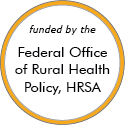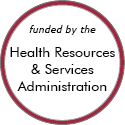Rural Project Examples: Health workforce
Effective Examples
Livingston County Help For Seniors

Updated/reviewed May 2020
- Need: Meeting the health needs of geriatric patients in rural Livingston County, New York.
- Intervention: The Help for Seniors program was developed and using its 'vodcasts,' local EMTs were trained in geriatric screening methods and health needs treatment.
- Results: In addition to developing a successful model for educating EMS personnel, the program screened over 1200 individuals and identified various risks among the geriatric population.
Promising Examples
SASH® (Support and Services at Home)
Updated/reviewed April 2025
- Need: In Vermont, the growing population of older adults, coupled with a lack of a decentralized, home-based system of care management, poses significant challenges for those who want to remain living independently at home.
- Intervention: SASH® (Support and Services at Home), based in affordable housing and their surrounding communities throughout the state, works with community partners to help older adults and people with disabilities receive the care they need so they can continue living safely at home.
- Results: Compared to their non-SASH peers, SASH participants have been documented to have better health outcomes, including fewer falls, lower rates of hospitalizations, fewer emergency room visits, and lower Medicare and Medicaid expenditures.
Successfully Training and Educating Pre-medical Students (STEPS)
Updated/reviewed March 2025
- Need: To increase the number of primary care providers in northeast Kentucky.
- Intervention: STEPS provides support such as physician shadowing, mock interviews, and MCAT practice courses/exams for regional students applying to medical school.
- Results: Approximately 65% of participants have been accepted into medical school. The program has been replicated among most of Kentucky's regional AHECs.
Health without Borders


Updated/reviewed January 2025
- Need: To improve the health of communities in the south central region of New Mexico.
- Intervention: A program was developed to address diabetes prevention and control, behavioral healthcare, and immunization in Luna County.
- Results: During the program, 1,500 immunizations were distributed, baseline measurements of participants improved, and 935 new patients were seen for behavioral health issues.
Nurse Navigator and Recovery Specialist Outreach Program

Updated/reviewed December 2024
- Need: To properly address and treat patients who have concurrent substance use disorders and chronic healthcare issues.
- Intervention: A referral system utilizes community health workers (CHWs) in a drug and alcohol treatment setting. A registered nurse helps with providers' medication-assisted treatment programs.
- Results: This program has reduced hospital emergency visits and hospital readmissions for patients since its inception.
Health Extension Regional Offices (HEROs)
Updated/reviewed May 2024
- Need: People in rural New Mexico often found it difficult to find and utilize needed resources from the University of New Mexico Health Sciences Center (UNMHSC).
- Intervention: UNMHSC created Health Extension Regional Offices (HEROs), in which HERO agents live in the communities they serve, help identify health and social needs, and link them with UNMHSC and other university resources.
- Results: In their regions, HERO agents' activities have been wide-ranging, including recruiting physicians, mobilizing research funds to address local priorities, working on economic development, training laypeople in Mental Health First Aid, and helping local institutions access UNMHSC resources.
TUSM-MHMMC Program Longitudinal Integrated Clerkship

Updated/reviewed April 2024
- Need: To fill vacant medical positions in Maine's rural medical facilities.
- Intervention: The Tufts Maine Track LIC program offers clerkships in rural medical facilities, exposing medical school students to the positives and possibilities that rural practices have to offer.
- Results: The program has seen an increase in students' interest in practicing in rural Maine. The majority of participants have pursued medical careers in one of the six core specialties studied during their clerkship.
Other Project Examples
Club Scrub
Updated/reviewed December 2025
- Need: Impact healthcare workforce shortages in rural Wisconsin.
- Intervention: The Rural Wisconsin Health Cooperative, leveraging evidence-informed grow-your-own pipeline activities to generate interest in health-related professions, partnered with the Wisconsin Office of Rural Health to create the Club Scrub program for 7th and 8th graders.
- Results: The original 2006-2007 program results revealed that participants gained a better understanding of career options in the healthcare industry and annual Club Scrub events continue to be sponsored by several Wisconsin rural healthcare delivery systems.
Mobile Integrated Healthcare Network (MIHN)

Updated/reviewed November 2025
- Need: To bring preventive care and other services to rural Missouri patients with chronic illnesses and difficulties accessing primary care.
- Intervention: Community paramedics make home visits and provide basic care, home assessments, and medication reconciliation and facilitate telehealth visits.
- Results: Patients experienced improved access to care, health status, and compliance with medication regimens along with increased patient engagement, satisfaction, and access to community resources.
Wisconsin Collaborative for Rural Graduate Medical Education
Updated/reviewed November 2025
- Need: Primary care physicians in the rural areas of Wisconsin.
- Intervention: A GME collaborative and technical assistance center that provides leadership, GME expertise, and support for expanding rural graduate medical education in Wisconsin.
- Results: The collaborative expanded rural graduate medical education opportunities which now include over 30 rural-focused residency programs. There are several GME opportunities in specialties ranging from family medicine to surgery, obstetrics/gynecology, psychiatry, internal medicine and more.
For examples from other sources, see:
